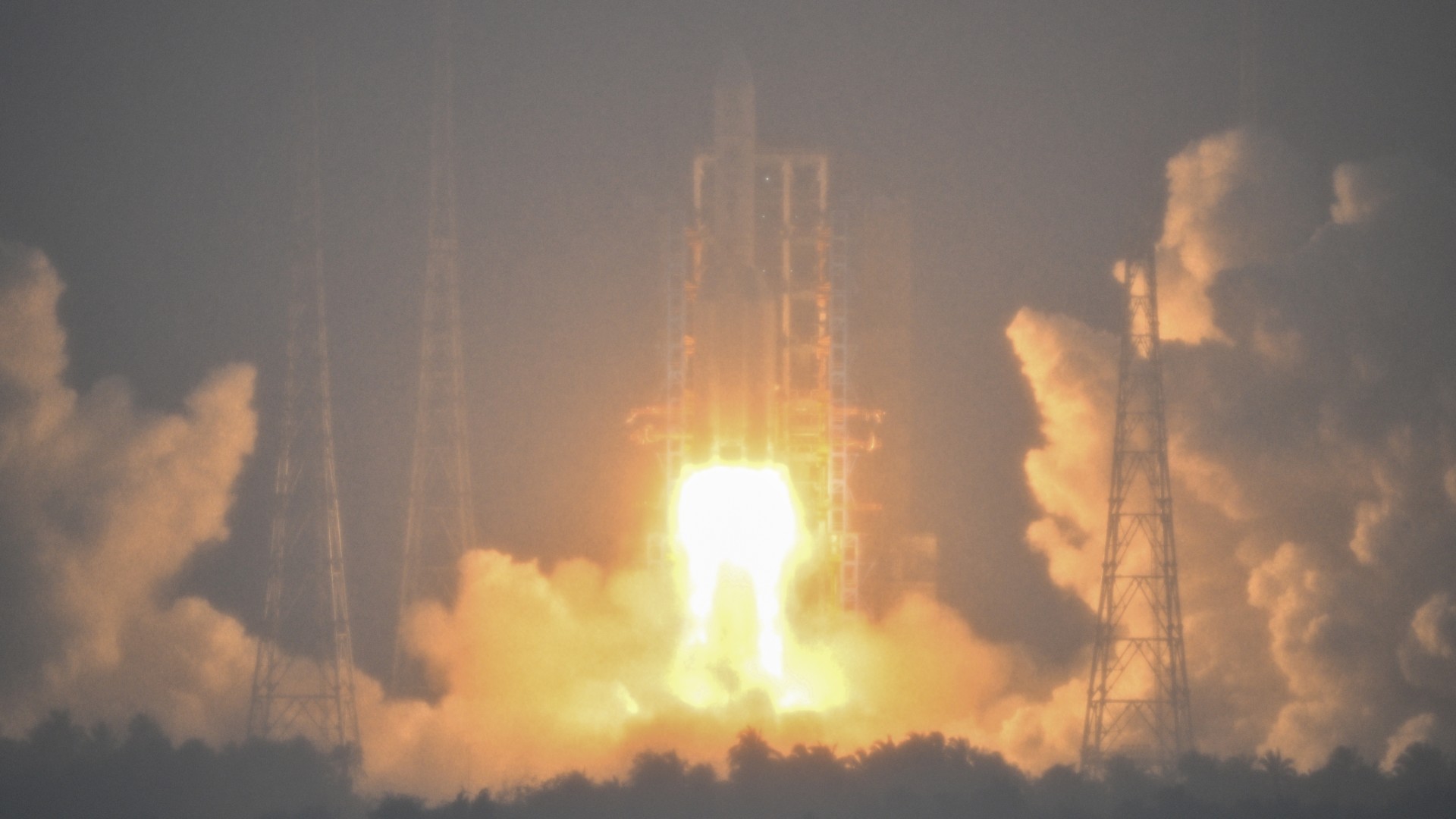
China is headed back to the moon's mysterious far side — and this time, the nation will bring back some souvenirs.
The robotic Chang'e 6 mission launched today (May 3) at 5:27 a.m. EDT (0927 GMT; 5:27 p.m. Beijing time), riding a Long March 5 rocket off a pad at the Wenchang Space Launch Site, in southern China's Hainan province.
If all goes according to plan, Chang'e 6 will touch down on the moon's far side, scoop up some samples and rocket them back to Earth — something that's never been done before. Indeed, just one mission has ever soft-landed on the lunar far side: Chang'e 4, which put a lander-rover duo down in January 2019.
Related: The latest news about China's space program

The moon's hidden face
The moon is tidally locked to Earth, completing one rotation in the same amount of time it takes to orbit our planet. This means that observers on Earth only ever see one face of the moon — what we call the near side.
In addition to being more familiar than the far side, the near side is easier for us to explore, which explains why every surface mission prior to Chang'e 4 — including NASA's crewed Apollo efforts in the late 1960s and early 1970s — had targeted that face.
A rover or lander mission to the far side faces communications challenges, requiring a lunar orbiter to relay messages to and from mission control here on Earth. China launched just such a relay satellite, called Queqiao, ahead of Chang'e 4 and sent another one, Queqiao 2, toward lunar orbit this past March to prepare for Chang'e 6 and subsequent surface missions.
There are compelling reasons, beyond the spirit of curiosity and exploration, to study the far side up close, scientists stress. It's very different from the near side; for example, while large plains of basalt known as maria cover about one-third of the moon's familiar face, these dark "seas" of volcanic rock comprise just 1% of the far side's surface.
Researchers don't know what accounts for such differences, and they hope that getting an up-close look at samples from the far side may help them figure it out.
Related: The moon: Everything you need to know about Earth's companion

A complex mission
Chang'e 6 consists of four elements: a lunar orbiter, a lander, an ascender and an Earth-reentry module.
If all goes according to plan, the lander (with attached ascender) will touch down inside Apollo crater, which is part of the South Pole-Aitken (SPA) basin, one of the largest impact craters in the solar system. The SPA basin is about 1,600 miles (2,500 kilometers) wide, and its ancient, battered rocks hold clues about the moon's early history and evolution.
"The region has long been thought of as a keystone to understanding how and when massive objects pelted the moon and Earth billions of years ago, and why the far side of the moon is so different from the near side," the nonprofit Planetary Society wrote in a description of the Chang'e 6 mission.
The Chang'e 6 lander will collect 4.4 pounds (2 kilograms) of lunar dirt and rock, some of it scraped from the surface and some of it drilled from up to 6.5 feet (2 meters) underground. This material will then launch aboard the ascender, which will rendezvous with the lunar orbiter.
The samples will be transferred to the reentry module, which rides aboard the orbiter. The orbiter will then head back to Earth, releasing the reentry module for a fiery trip through Earth's atmosphere. This entire journey, from today's launch to the samples' arrival on Earth, is expected to take 53 days.
The mission architecture is similar to that of China's first-ever lunar sample-return mission, Chang'e 5, which delivered material from the near side to Earth in December 2020. That's not surprising, given that Chang'e 6 was built as a backup to Chang'e 5.
Chang'e 5's success made China just the third nation to ace a lunar sample-return mission, after the Soviet Union and the United States. The vast majority of moon material brought to Earth was done so by Apollo astronauts, who hauled home 842 pounds (382 kg) of the stuff between 1969 and 1972.
A new moon race?
Chang'e 6 is part of a concerted and ambitious lunar push, which China hopes will lead to a crewed landing on Earth's nearest neighbor by 2030.
And that initial astronaut mission is not designed to be a one-off. In the 2030s, China plans to build a crewed outpost near the moon's south pole called the International Lunar Research Station (ILRS), with help from Russia and other international partners.
China has already begun testing some of the tech that could help lay the foundation for the ILRS. In March, for example, the Queqiao 2 relay satellite launched along with two other spacecraft called Tiandu 1 and Tiandu 2, which are carrying out communication and navigation experiments near the moon. Such work will help guide the design of the ILRS and associated infrastructure, Chinese space officials have said.
And China is not alone in its lunar ambitions. NASA also plans to establish a crewed base near the south pole via its Artemis program. The American space agency aims to launch astronauts around the moon next year on its Artemis 2 mission, then follow that up with a crewed landing on Artemis 3 in 2026.
Some American politicians and government officials, including NASA chief Bill Nelson, have characterized the current situation as a new "moon race" with China. It's important for the U.S. to win this race, Nelson and others have said, so that it can set precedents for responsible exploration of the moon and beyond.







